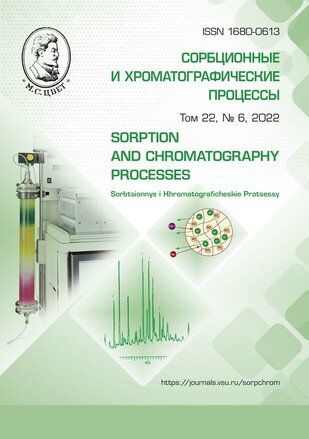Optimising the method of isolating nucleic acids from kefir using a silica-based sorbent
Abstract
The most common methods of nucleic acid isolation are those using sorption carriers. The general principle of the methods for solid-phase extraction is based on the use of silica whose unique properties provide for selective DNA and RNA binding. The purpose of the work was to analyse the quality of sorption-based extraction systems using guanidine thiocyanate of various concentrations and 4 types of detergents in the lysis solution when extracting nucleic acids from kefir as a fermented dairy food product containing bacterial and fungal cells.
For the study, we used a commercially available fermented dairy food product “Kefir” with the bacteria content of at least 107 CFU/g and yeast content of at least 104 CFU/g. 99% silica (Sigma-Aldrich, USA) was used to isolate DNA. The experiment considered 3 variants of guanidine thiocyanate concentrations: 3.5 M, 5 M, and 6.5 M, as well as 4 variants of detergents: 1% Triton X-100, 1% Tween 20, 1% Tween 80, and 1% CTAB. Thus, DNA extraction was carried out in 12 different variants.
DNA obtained after extraction was visualised by electrophoresis in 2% agarose gel. The DNA concentration was measured using a Qubit 4 fluorometer (Thermo Fisher Scientific, USA). The polymerase chain reaction was performed using Taq polymerase on the CFX96 Real-Time System (Bio-Rad, USA). Statistical data processing was carried out using ANOVA dispersion analysis in the Statistica software.
Electrophoresis in agarose gel showed that using 5 M and 6.5 M concentrations of guanidine thiocyanate contributed to obtaining more pronounced rRNA bands on the electropherogram when using Tween 80, whereas when using Tween 20, the optimal concentration of guanidine thiocyanate for DNA extraction was 5 M.
The analysis of the effect of detergents on the quality of DNA isolation showed that the minimum concentration of extracted DNA was obtained when using CTAB and it was 1.03 ng/μl. Triton X-100 used as a detergent allowed obtaining a DNA concentration 5.9 times higher than with the CTAB detergent (p < 0.001). The values obtained from the extraction using Tween 80 and Tween 20 were 3.1 and 3.9 times higher, respectively, than the concentrations when using CTAB (p<0.05). Real-Time PCR conducted to assess the threshold cycle parameter (Ct) showed that the obtained Ct values with ITS1 and ITS4 primers in all variants of DNA extraction do not allow assessing the quality of isolation of nucleic acids from fungi. The analysis of Ct with primers 337F and 1100R suggests that the optimal concentration value for guanidine thionation was 5 M (the average value of Ct for all detergents was 25.0). According to the results of the experiment, it was found that when isolating nucleic acids from kefir, it is necessary to use guanidine thionation at a concentration of 5 M or 6.5 M. The concentration of isolated DNA was higher when using Triton X-100 and Tween 20 as a detergent. The use of Tween 20 or Tween 80 as detergents significantly increased the RNA fraction in the nucleic acid preparation.
Downloads
References
Cheng H.R., Jiang N. Extremely Rapid Extraction of DNA from Bacteria and Yeasts. Biotechnol. Lett. 2006; 28: 55-59. https://doi.org/10.1007/s10529-005-4688-z
Niemi R.M., Heiskanen I., Wallenius K. et al. Extraction and purification of DNA in rhizosphere soil samples for PCR-DGGE analysis of bacterial consortia. J. Microbiol. Methods. 2001; 45: 155-165. https://doi.org/10.1016/s0167-7012(01)00253-6
Madhu B., Lakdawala M.F., Gumien-ny T.L. Small-Scale Extraction of Caenorhabditis elegans Genomic DNA. J. Vis. Exp. 2022; 184. https://doi.org/10.3791/63716
Muller F.M., Werner K.E., Kasai M. et al. Rapid extraction of genomic DNA from medically important yeasts and filamentous fungi by highspeed cell disruption. J. Clin. Microbiol. 1998; 36: 1625-1629. https://doi.org/10.1128/JCM.36.6.1625-1629.1998
Paul R., Ostermann E., Wei Q. Advances in point-of-care nucleic acid extraction technologies for rapid diagnosis of human and plant diseases. Biosens. Bioelectron. 2020; 169: 112592. https://doi.org/10.1016/j.bios.2020.112592
Greathouse K.L., Sinha R., Vogtmann E. DNA extraction for human microbiome studies: the issue of standardization. Genome Biol. 2019; 20: 212. https://doi.org/ 10.1186/s13059-019-1843-8
Boom R., Sol C.J., Salimans M.M. et al. Rapid and simple method for purification of nucleic acids. J. Clin. Microbiol. 1990; 28: 495-503. https://doi.org/ 10.1128/jcm.28.3.495-503.1990
Cady N.C., Stelick S., Batt C.A. Nucleic acid purification using microfabricated silicon structures. Biosensors & Bioelectronics. 2003; 19: 59-66. https://doi.org/10.1016/s0956-5663(03)00123-4
Rimola A., Costa D., Sodupe M. et al. Silica surface features and their role in the adsorption of biomolecules: computational modeling and experiments. Chemical Re-views. 2013; 113: 4216-4313. https://doi.org/10.1021/cr3003054
Zhang Y., Cremer P.S. Interactions between macromolecules and ions: the Hofmeister series. Current Opinion in Chemical Biology. 2006; 10: 658-663. https://doi.org/10.1016/j.cbpa.2006.09.020
Poeckh T., Lopez S., Fuller A.O. et al. Adsorption and elution characteristics of nucleic acids on silica surfaces and their use in designing a miniaturized purification unit. Analytical Biochemistry. 2008; 373: 253-262. https://doi.org/10.1016/j.ab.2007.10.026
Günal G., Kip Ç., Eda Öğüt S. et al. Comparative DNA isolation behaviours of silica and polymer based sorbents in batch fashion: monodisperse silica micro-spheres with bimodal pore size distribution as a new sorbent for DNA isolation. Artif. Cells Nanomed. Biotechnol. 2018; 46: 178-184. https://doi.org/10.1080/21691401.2017.1304404
Chen Y., Guo Z., Wang X. et al. Sample preparation. J. Chromatogr. A. 2008; 1184: 191-219. https://doi.org/10.1016/j.chroma.2007.10.026
Campos P.F., Gilbert M.T.P. DNA Extraction from Keratin and Chitin. Meth-ods Mol. Biol. 2019; 1963: 57-63. https://doi.org/10.1007/978-1-4939-9176-1_7
Linke D. Detergents: an overview. Methods Enzymol. 2009; 463: 603-617. https://doi.org/10.1016/S0076-6879(09)63034-2
Lõoke M., Kristjuhan K., Kristjuhan A. Extraction of genomic DNA from yeasts for PCR-based applications. Biotechniques. 2011; 50: 325-328. https://doi.org/10.2144/000113672
Barazesh A., Sarkari B., Ebrahimi S. et al. DNA extraction from hydatid cyst protoscolices: Comparison of five different methods. Vet. World. 2018; 11: 231-234. https://doi.org/10.14202/vetworld.2018.231-234
Chen F., Ye J., Chio C. et al. A simplified quick microbial genomic DNA extraction via freezethawing cycles. Mol. Biol. Rep. 2020; 47: 703-709. https://doi.org/10.1007/s11033-019-05176-w
Teyssier N.B., Chen A., Duarte E.M. et al. Optimization of whole-genome sequencing of Plasmodium falciparum from low-density dried blood spot samples. Malar. J. 2021; 20: 116. https://doi.org/10.1186/s12936-021-03630-4
Demeke T., Ratnayaka I., Phan A. Effects of DNA Extraction and Purification Methods on Real-Time Quantitative PCR Analysis of Roundup Ready Soybean. J. AOAC Int. 2009; 92: 1136-1144. https://doi.org/10.1093/jaoac/92.4.1136
Kuhn R., Böllmann J., Krahl K. et al. Comparison of ten different DNA extraction procedures with respect to their suitability for environmental samples. J. Microbiol. Methods. 2017; 143: 78-86. https://doi.org/10.1016/j.mimet.2017.10.007
Boom R., Sol C.J., Salimans M.M. et al. Rapid and simple method for purification of nucleic acids. J. Clin. Microbiol. 1990; 28: 495-503. https://doi.org/10.1128/jcm.28.3.495-503.1990
White T.J., Bruns T., Lee S. et al. Amplification and direct sequencing of fungal ribosomal RNA Genes for phylogenetics. In: PCR Protocols: A Guide to Methods and Applications. New York: Academic Press, 1990, vol. 18, P. 315-322.
Techo S., Shiwa Y., Tanaka N. et al. Enterococcus florum sp. nov., isolated from a cotton flower (Gossypium hirsutum L.) Int. J. Syst. Evol. Microbiol. 2019; 69: 2506-2513. https://doi.org/10.1099/ijsem.0.003524







